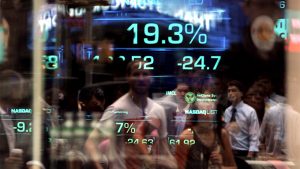From the editor: The Art of the Doomsayer – Crisis? What Crisis?
 Just as a broken watch still tells the right time twice a day, the persistent doomsayer will eventually be vindicated. In the financial world, entire reputations are built on predicting recessions, if not depressions: keep it up long enough and the world will recognise the professional pessimist as a sage the moment indicators turn south.
Just as a broken watch still tells the right time twice a day, the persistent doomsayer will eventually be vindicated. In the financial world, entire reputations are built on predicting recessions, if not depressions: keep it up long enough and the world will recognise the professional pessimist as a sage the moment indicators turn south.
The good people of Royal Bank of Scotland (RBS) this week joined the chorus of doomsayers, predicting the imminent arrival of yet another financial meltdown. RBS economists expect a “cataclysmic year” with oil prices dropping to around $16 per barrel and stocks losing twenty percent or more of their value. The bank advises its clients to immediately liquidate all equities save for high quality bonds.
Analysts at US investment bank Morgan Stanley promptly joined the bandwagon dispensing advice not dissimilar to that of investor and financial guru George Soros who urges caution in the face of a rudderless market. Earlier this month, Mr Soros said that current conditions remind him of those prevalent during the lead-up to the 2008 crisis. In particular, Mr Soros worries that market volatility is reaching dangerous levels.
“In fact, Oxford Economics and other think tanks are moderately bullish on the economic prospects of net commodity importers, including the European Union, South Korea, Japan, and India.”
Though the Chicago Board Options Exchange Volatility Index (VIX), otherwise known as the fear gauge, has receded from its late August 2015 spike, the index has inched back up since. In Japan, the Nikkei Stock Average Volatility Index, which measures the hedging cost on shares, has leapfrogged 43% during the first five days of trading in 2016.
These anxieties are, of course, largely ascribable to the erratic behaviour of the market in China where authorities had to shut down trading twice this year in order to contain losses, invoking circuit breaker rules that halt transactions when losses amount to five percent and suspend trading outright when the minus seven percent mark is reached.
Chinese markets soured in anticipation of the lifting of a ban on the sell-off of large chunks of shares in local companies, implemented in July 2015 and directed at major investors. The injunction was meant to ease the pressure on the yuan by stemming the rush of capital out of the country. The ban has now been extended for an additional three months.
While it allowed the yuan to slide by about six percent over the past five months, the People’s Bank of China has now dug its heels in the sand, buying up vast amounts of the currency in order to underpin its value. The intervention is mostly channelled via Hong Kong where the yuan’s overnight borrowing cost shot up to 67% – from barely 4% when the exercise resumed last week. In 2015, efforts to prop up the exchange rate are estimated to have reduced China’s foreign currency reserves by up $500bn.
“They are really trying to stop a panic,” said emerging market analyst Lucy Qiu of UBS Wealth Management in New York. Meanwhile, analysts at Oxford Economics, a commercial spinoff of Oxford Business College, warn that China’s slowdown will further depress commodity prices and thus disproportionally affect countries such as Brazil, Chile, South Africa, and Australia.
However, the concerns expressed by George Soros and others largely focus on China’s debt-to-GDP ratio which over the last four years increased from 190% to 240%. Conventional wisdom dictates that ballooning debt levels are indicative of credit being extended without due diligence – just as US lenders merrily awarded no-doc mortgages to all and sundry during the 1990s and right up to the 2008 meltdown. However, with greater state control of the economy and vast amounts of readily available cash to bail out banks, China is exceptionally well equipped to handle a major debt crisis.
Few pundits dispute the assertion that the Chinese economy is in for a hard landing. Arguments arise when it comes to assessing the impact of a low-to-no-growth China on the wider world. Operating in a largely closed environment, the fallout of any Chinese financial crisis is expected to be limited in scope. The exposure of systemically important US and European banks to China is negligible with under one percent of German and French bank assets at risk.
In fact, Oxford Economics and other think tanks are moderately bullish on the economic prospects of net commodity importers, including the European Union, South Korea, Japan, and India. “A slowdown in China redistributes global economic activity through the commodity channel as much as dampens it,” writes lead economist Adam Slater. Though not directly affected by China’s travails, Europe may continue to suffer deflationary pressures as oil and other commodities continue their downwards slide.
The casual observer may indeed wonder why cheap oil could possibly cause havoc, given that low-cost energy would seem a boon to consumers, industry, and transporters alike. While the real economy – the one in which business produce goods and services that others consume – stands to benefit from cheap oil, those seeking a shortcut to riches do not. The multitudes who are long on oil – betting up to and including the proverbial kitchen sink on a rebound of the oil price – may be in for a rude awakening.
However, for every futures trader who is on the wrong side of the equation, there is another one about to make a killing. Vast volumes of money are about to shift from bullish to bearish investors. The problem is with those not trading futures, but their offshoots such as exchange traded funds (ETFs) tracking the price of oil and other commodities. These are largely leveraged one-way bets in which losses can mount quickly when reality fails to cover the odds.
Historical parallels with 2008 are largely unwarranted. Instead, the present touches more closely upon 1998 when Asian nations outdid each other devaluing their currencies once the realisation had set in that the region’s growth had turned into a speculative bubble. As China aims to keep its economy humming at above average growth rates by allowing the yuan to depreciate – if only to keep its masses from becoming unemployed and restless – other countries in the region may have to follow suit for fear of losing their competitive edge.
For now, though, the People’s Bank of China seems content to leave things as they are, limiting its interventions to the maintenance of the status quo. It is a rather delicate balancing act: selling dollars to prop up the yuan tightens domestic liquidity which may exacerbate the problems suffered by corporates that have so far managed to survive on easy credit.
It is not so much a question if the bubble will burst; but rather which bubble will burst when. Depressed commodity prices are helpful in postponing the day of reckoning. No doomsayers are required in order to predict that eventually some bubble will burst somewhere. In that sense, economics is not unlike weather forecasting: you never get it right all of the time, but do get lucky every now and then. The lesson for the rest of us: carry on and try to stay calm.
You may have an interest in also reading…
UN: Towards a Rights-based Approach to Migration
The General Assembly High-level Dialogue on Migration and Development opened on Thursday 3rd October in New York with a call
Hildegunn Kyvik Nordås: Why Do Countries Regulate Differently and How Does It Affect Trade?
The case of professional services in the European Union. Explicit barriers to cross-border trade in services are rare… Since services
UNCDF: COP27 Pledges Biodiversity Finance to Boost Climate-Change Resilience
Forests, coral reefs and populations most at-risk come into focus at 2022 summit in Egypt. “From the beginning, this conference



















































































